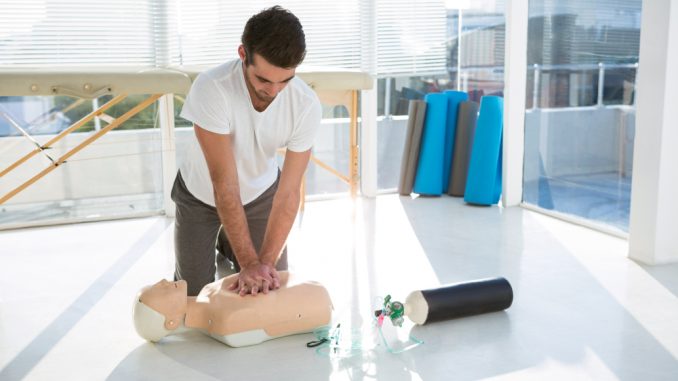
MAGE SOURCE: ENVATO
According to AHA (American Heart Association), cardiac arrest is one of the leading causes of death. The premise of this finding is partly because few cardiac arrest patients get immediate help through CPR. CPR can triple a patient’s chances of survival. Therefore it’s necessary you know how to administer CPR.
What are CPR and AED?
Cardiopulmonary Resuscitation is a procedure administered to cardiac arrest victims. This life-saving procedure often raises the chances of survival.
AED is a portable medical device that analyzes a user’s heart rhythm and delivers a shock in case of an arrest. You attach the pad to a victim’s chest and let it analyze and deliver the shock. Learning how to use an AED goes hand in hand with learning CPR.
Therefore, you must have basic training in CPR and AED. Fortunately, unlike most medical procedures, you can get your CPR/AED training online.
But first, get a grasp of some of the facts about CPR.
1. A Heart Attack is Not A Cardiac Arrest
Many people can’t differentiate the two as they often appear the same. However, these two conditions are different, and it’s crucial you learn to differentiate the two.
Cardiac arrest is the sudden stop of the heartbeat, while a heart attack is the blocking of blood flow to the heart. Of the two, cardiac arrest is the most fatal. During a cardiac arrest, the heart stops beating, while in contrast, the heart keeps beating during a heart attack.
However, a heart attack can lead to cardiac arrest. Knowing the difference helps you gauge whether to perform CPR or not.
2. Know What To Do
There are several resuscitation techniques all used depending on given situations. For instance, a cardiac arrest from anaphylactic attacks (allergy attacks) requires an auto-injector to administer the right epinephrine dose.
Other resuscitation techniques include airway management for drowning victims and CPR. With airway management, ensure you clear your patient’s airway by offering mouth to mouth and CPR. Also, clear the lungs to initiate breathing.
The right resuscitation technique guarantees effectiveness. Therefore, it’s necessary you know what to do whenever you’re next to someone suffering from cardiac arrest.
3. Know Your Laws
Often at times, bystanders fear offering first aid. These fears stem from several legal suits brought on bystanders involved in first aid. Fortunately, there are good Samaritan laws that help clear that fear out.
These laws protect both the bystander and the victim. A bystander is held liable if they fail to take action in cases of a medical emergency. On the other hand, the victim cannot sue a bystander that administered first aid to them.
Knowing and distinguishing these laws puts a clear picture of what your rights are when administering a resuscitation. Therefore, visit the government website and verse yourself with your state’s good Samaritan law.
4. Technology Keeps On Improving CPR
CPR appeared in the public light first in 1704. And with time, this life saving out-of-hospital procedure has undergone numerous improvements. These improvements stem from constant research on this medical procedure.
Technology has offered new ways to approach this resuscitation technique; some of these methods include seamless communication with a medical practitioner or online courses for interested individuals.
Furthermore, new ways to administer CPR have been invented while the previous ones being improved. Such advancements mean that constant recertification in this field is necessary. Therefore, ensure you update your skills regularly once you take your first CPR/AED training course.
5. Cardiac Arrests Often Happen in Public
Cardiac arrests rarely occur in the hospital. Over 88 percent of cardiac arrests happen at home. These findings back the necessity of taking up a resuscitation technique course.
Learning CPR increases the chances of you saving a life in public just from administering CPR. Therefore take up one of these courses, and you may save the life of a loved one someday.
While CPR might increase the chances of saving a life, this technique is not fool-proof as it sometimes doesn’t work. However, it’s still useful when administered in the early stages of the attack.
Learning the facts surrounding resuscitation techniques offers an overview of what to do and expect during a cardiac arrest. Therefore verse yourself with the points above before taking up training.

Leave a Reply